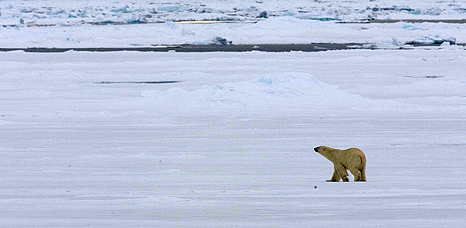A client travelled on our 'Spitsbergen- Realm of the Polar Bear' tour and submitted this entry to our writing competition.

Polar Bear by Paul Stanbury
He is hunting. Clearly through my binoculars, I can see his focus, his control, his frozen awareness. Then the bear is off, bounding across the ice and launching himself, leaping and crashing into a seal’s breathing hole. For two extraordinary, comical moments, he is completely upside-down, head and forepaws wedged below the ice, hind legs kicking the air and stumpy tail wagging in a frenzy of effort to catch his escaping prey. It seems impossible that he will have the leverage to extricate himself, but his hind legs return to the ground, hairy paws provide the necessary grip, and he pulls his head and shoulders back out of the water. Disappointed but resigned, he paces about a bit before choosing a place to rest. He briefly raises his head to acknowledge the presence of our ship, but sees no threat and settles to sleep. A failed hunt now in early July is not a disaster. Catching one seal a week will do, but the odds are not in his favour. Here on the east coast of Spitsbergen, the current takes the ice in the wrong direction - south. On this trip, we see a total of 15 bears, including two mothers with cubs, all cut off from the pack-ice with its abundant supply of seal meals. We know exactly where the pack-ice is: we have sailed to its edge at 81 degrees 27 minutes north. At that point in our journey, watching graceful ivory gulls flying through the mist, we could well have been the most northerly people on the planet.
We are circumnavigating Spitsbergen on the ‘Plancius’, a former polar research ship with plenty of on-board comfort, and plenty of Zodiacs to take us out of that comfort zone. With tales of past explorers, trappers and marooned sailors ringing in our ears, wearing multiple layers and sturdy wellies, we wade ashore onto beaches of sand or gravel, where there are piles of Siberian driftwood, and sometimes piles of walrus. Mature walruses huddle together in large groups, and we stand just 30 metres away, marvelling at their size, their tusks, their smell and their surprisingly colourful skins. Three juveniles are curious about the Zodiac and swim within touching distance.
Some walks take us into glacier-worn valleys, some to a polar desert of arid, uplifted seabed. Underfoot there may be wobbly, lichen-spotted boulders, snowfields, or rocks split by repeated freezing into their sedimentary layers – sliced bread for trolls, we are told. Best of all, a walk will take us onto the boggy tundra, where wild reindeer graze. At times we almost tread on a nesting bird. A purple sandpiper tries to lure us away with its broken wing act; an eider duck flies off in a panic; the skuas remain fairly unconcerned if we keep our distance, but the arctic terns attack us. The little auks are too nervous to land in their nesting colony, and wheel about like murmurating starlings, but it is not our presence alarming them. An arctic fox is on the prowl.
Everywhere on the tundra there are flowering plants among the rocks, grasses and mosses. Some are tiny versions of old favourites: poppies, saxifrage and buttercups. Others are new to me: minuartia and draba. Most strange of all is the polar willow, complete with catkins, but only an inch high. This minuscule tree will never make cricket bats.
If there is nowhere to walk, we can cruise close to shore in a Zodiac. There is no vantage point better for observing the guillemots and kittiwakes nesting on cliffs of basalt columns that rise straight out of the water. Brunnich’s and black guillemots land on the sea around us, before diving into the clear depths to fish.
It was the wildlife that tempted us to join this tour, but Spitsbergen has other sights to offer. The history spans 400 years, and there are the remains of trappers’ huts, scientific expeditions and whaling stations to be discovered, along with their stories. Amundsen lived here before his flight over the North Pole in 1926, and the mast that anchored his airship still stands at Ny Alesund. Even more compelling is the dramatic landscape. Everywhere you look there are ice-caps, craggy blue glaciers, and the pointed mountains that give Spitsbergen its name. It all screams to be captured in a sketch or in a photo. Finally, there is the never-setting sun. To see it shining high in the northern sky at midnight is surreal, but just part of the allure of this extraordinary place.
Read more about our 'Spitsbergen- Realm of the Polar Bear' holiday.



 Loading search...
Loading search...